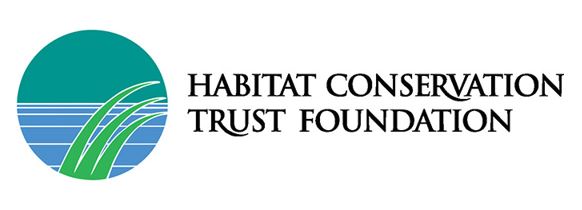Our best wishes for a safe and happy holiday season. Please note that our office will be closed December 26th through January 2nd. We look forward to working with you in 2017.
Category: News
Christmas Bird Count
‘Tis the season for the Christmas Bird Count, and Bird Studies Canada is hosting an event especially designed for young birders.
The Ladner Christmas Bird Count for Kids will take place this Saturday at the Reifel Bird Sanctuary in Delta, BC. Full detail are available here. Not in Delta? Visit Bird Studies Canada’s website to see if there’s another Christmas Bird Count event happening near you!
HCTF Announces Partnership with Forest Enhancement Society of BC


We are pleased to announce that the Habitat Conservation Trust Foundation (HCTF) has signed a Letter of Agreement (LOA) with the Forest Enhancement Society of British Columbia (FESBC). This one-year agreement will result in increased funding available for wildlife habitat projects, with FESBC prepared to contribute up to half a million dollars. This will be in addition to the two to three million dollars that HCTF grants to wildlife projects annually.
About FEBSC
In February 2016, the BC Government announced the formation of a new organization called the Forest Enhancement Society of BC (FESBC). At the time of its formation, the BC Government provided an initial contribution of $85 million to the Society.
The purpose of the Society is as follows:
A. To advance environmental and resource stewardship of British Columbia’s forests by:
- preventing and mitigating the impact of wildfires;
- improving damaged or low value forests;
- improving habitat for wildlife;
- supporting the use of fibre from damaged and low value forests; and
- treating forests to improve the management of greenhouse gases.
B. To advocate for the environmental and resource stewardship of British Columbia’s forests.
C. To do all such other things as are incidental and ancillary to the attainment of the foregoing purposes and the exercise of the powers of the Society.
You can find out more about FESBC by visiting their website at www.fesbc.ca
HCTF and FESBC: Natural Partners
Both HCTF and FESBC have a mandate to improve habitat for wildlife. HCTF has over 35 years of experience in administering grants for projects that enhance wildlife habitat in BC. By partnering with HCTF, FESBC will be able to efficiently identify high-quality projects that fulfill their mandate and make a meaningful contribution to conservation in BC. The partnership between HCTF and FESBC will also reduce the administrative burden on funding recipients by consolidating grant application and reporting requirements.
Investment of FESBC Funds
FESBC has chosen to use the HCTF application and technical review process to help select wildlife habitat projects they would like to fund. Proposals submitted to HCTF for enhancement & restoration grants by the November 4, 2016 deadline will be reviewed by committees of scientific experts to identify those that are technically sound, address important wildlife conservation issues, and have a high likelihood of success. Projects meeting these criteria will be considered by FESBC for funding, based on alignment with their mandate. Once FESBC has determined the amount they would like to contribute to selected projects, they will transfer this sum to HCTF, who will administer the grants. Recipients of FESBC funding will be notified by HCTF in March 2017, and HCTF and FESBC will jointly announce the list of grant recipients in April 2017.
Quote from Greg Anderson, Executive Director of the Forest Enhancement Society of BC:
“Improving wildlife habitat is an important part of FESBC’s mandate to advance stewardship of BC’s forests. We’ve chosen to partner with HCTF on the administration of these funds as they have a strong record of investing in scientifically-sound projects that have made important contributions to conservation in BC.”
Quote from Brian Springinotic, CEO of the Habitat Conservation Trust Foundation:
“HCTF is happy to have entered into a partnership with the Forest Enhancement Society of BC. This new funding will help meet an increasing need for resources to protect, restore and enhance wildlife habitat, to the benefit of all British Columbians.”
Volunteer at Salmon River Estuary
The Nature Trust (TNT) of BC ia hosting a volunteer event October 12-14 at the Salmon River Estuary Conservation Area near Sayward, Vancouver Island. Organizers are looking for volunteers to help replant native shrubs and trees to help restore this important wetland and riparian habitat.
This conservation property was purchased in 2015 by the Nature Trust of BC, with funding support from the Habitat Conservation Trust Foundation, Fish and Wildlife Compensation Program, Campbell River Salmon Foundation, Barnet Rifle Club, Steelhead Society of BC, Kingfishers Rod & Gun Club, Ducks Unlimited Canada, Totem Fly Fishers, Parksville-Qualicum Fish & Game Association, BC Federation of Fly Fishers, and individual donors from across BC. You can read more about the property here.
Anyone interested in helping with the planting is welcome to join TNT staff for all or part of the time. Bring your lunch, rain gear, gloves, and a shovel, if possible. The property is located south of the Village of Sayward, on the west side of the Salmon River, on Sayward Road, east of Frenchman Road, between the Salmon River and Hammond Creek bridges. Go to map>> For more information, contact Karen Barry on 250-713-3193
HCTF Now Accepting Proposals for 2017-18 Enhancement and Restoration Grants
Each year, HCTF provides approximately $6M in Enhancement and Restoration Grants for projects benefiting BC’s fish, wildlife and habitats. Proponents seeking HCTF funding for enhancement and restoration work taking place in 2017-18 must submit a proposal through HCTF’s web-based application portal, HCTF Online. The deadline for application submission is Friday, November 4, 2016 at 4:30pm PST. You may submit a proposal anytime between now and the deadline.
To begin your application, review the information on the Enhancement & Restoration Grant Overview, then continue on to the HCTF Online webpage where you will find instructions, examples and additional information to facilitate the application process. From this webpage, you can request a User ID and log on to the online application system.
What happens next?
Over the next few months, technical review committees assess each proposal and make recommendations to the HCTF Board. In early March, the Board meets to make final funding decisions and shortly thereafter a preliminary list of approved projects will be posted on this website. Proponents will then be notified by email of the status of their proposals in mid-March.
Job Posting – Conservation Specialist
HCTF is looking for a Conservation Specialist to join our team. For details, visit our Careers webpage.






